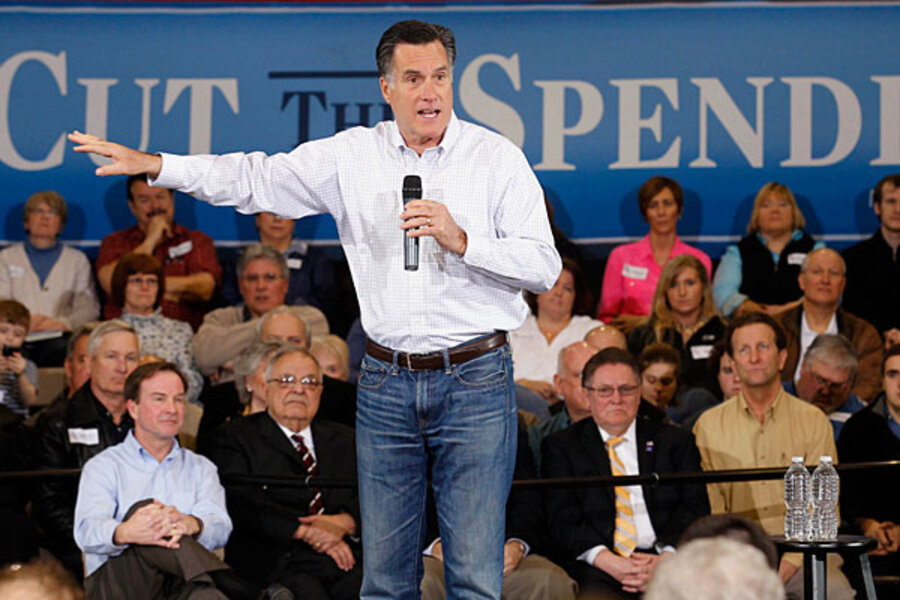Mitt Romney: His super PAC burn rate soared in January
Loading...
| Washington
There’s plenty of buzz about campaign fund-raising, as a Federal Election Commission deadline Monday night brought forth a trove of data from the campaigns about their January spending.
What do you need to know about the state of the campaign money game? Here are five things to note.
1. Show me the money - by state.
MapLight put together a chart showing that two out of every three dollars raised by super PACs - the groups that can raise and spend unlimited amounts of money for presidential candidates without coordinating with said candidates - have come from just four states and Washington, D.C. Mitt Romney has raised the most super PAC cash in each of those locations, but you can slice and dice the numbers for yourself here.
2. How much mud would a super PAC chuck if a super PAC could chuck mud?
Answer: A lot more than last time around, that’s for sure. In the last GOP presidential tilt, just six percent of campaign advertising was an attack on other candidates, the Washington Post writes. During this campaign cycle, that number has shot up to more than 50 percent. Nearly three quarters of super PAC ads have been negative compared with 27 percent of ads from the campaigns themselves.
3. How do the GOP candidates compare to each other?
See this super helpful ABC News chart for the numeric breakdown, but here are DCDecoder’s takeaways. Mitt Romney had the biggest fund-raising haul of the Republican bunch - but he put $6.5 million in the tank versus $4.5 million to $5.5 million for each of his rivals.
What’s really amazing is how much Mitt Romney spent - $18.78 million. The New York Times’ Nate Silver thinks Romney’s “burn rate” - fund-raising minus spending - of negative $12.2 million might be the worst January ever. Rick Santorum saw his cash on hand grow by about $1 million while Ron Paul and Newt Gingrich had losses in the hundreds of thousands of dollars.
Romney’s burn rate looks even worse when you add in the net negative $7 million hit his super PAC took in January. Still, his $24 million in cash between the super PAC and his campaign dwarf the other candidates’ combined holdings.
Which would be great, except that Rick Santorum is breathing down his neck in two states that everybody thought were Romney shoo-ins - Arizona and Michigan.
4. How do the GOP candidates compare to Barack Obama?
The longer the GOP primary goes, the bigger Obama’s cash advantage grows.
As Tuesday's Washington Post’s Morning Fix points out, the four GOP candidates have $13 million in cash - combined. President Obama has nearly six times that amount at $76 million. While the President’s super PAC had a dreadful month of under $100,000 raised, Obama has since reversed his willingness for his campaign to seek super PAC fundraising and so that number is almost certainly to rise - it can’t go down much farther.
Obama actually had a negative burn rate during the month of around $6 million. However, the president is getting to invest in staff, technology, and organization more than television advertisements. It’s not as if the GOP candidates aren’t getting to do this, but the emphasis is different - and likely offers a better springboard to the general election.
5. What’s next on the fund-raising trail?
After Santorum’s mid-January sweep of Minnesota, Colorado and Missouri, DCDecoder wrote that he’d have to up his fund-raising game. He has. The next two weeks, however, will move at warp speed. First up are the Arizona and Michigan primaries, followed shortly thereafter by Washington and then the explosion of delegates available on “Super Tuesday,” March 6.
With Newt Gingrich backer Sheldon Adelson promising another $10 million for the former House speaker, Ron Paul steady as ever and Santorum showing he can put money in the bank, its putting campaign treasure to its best use that will be at a premium before the next set of campaign disclosures appears.
— David Grant / @DW_Grant
Watch the top Republican candidates face off in the CNN Republican Presidential debate live from Arizona! Wednesday night at 8 ET on CNN (Sponsored message).
Like your politics unscrambled? Go to DCDecoder.com





